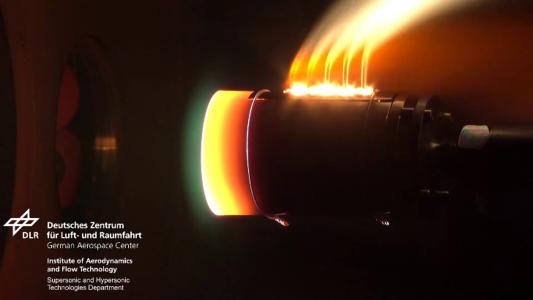Spacecraft demise during re-entry expedited using various exothermic reactions
Programme
TDE
Programme Reference
T711-601MS
Prime Contractor
HTG- HYPERSCHALL TECHNOLOGIE Goettingen GmbH
Start Date
End Date
Status
Contracted
Country
Germany

Objectives
Verify viability, design and optimise highly energetic exothermic reactions (thermite) for demise purposes and fuse concepts to reliably provide ignition at various temperatures
Description
Uncontrolled spacecraft re-entry requires the satellite to sufficiently demise in order to meet the casualty risk requirement. Heat generated during re-entry is not adequate to sufficiently demise some spacecraft equipment.
- Equipment (e.g. Large mechanisms, magnetorques, optical equipment) is hard to demise without big design changes as the functionality requires using metals with high melting temperatures.
- Earlier break-up of the interface of equipment to the structure, harness and pipework is beneficial for demisability.
This activity investigates technologies which add energy to the system to aid the demise. Thermite is integrated into the equipment design to provide the additional energy to melt the materials. With limited additional mass, it should be possible to add the energy required to further demise the equipment. Such technology provides a paradigm shift, from redesigning all equipment for demise, to demising existing equipment with minor changes leveraging existing heritage and minimising the need for extensive redesign and qualification. The concept is also appropriate for use in new designs, i.e. One off products, e.g. Optical equipment.
The ESA patent "Spacecraft demise during re-entry expedited using various exothermic reactions" on this topic has recently been filed. In addition, a TAS activity is ongoing (planned completion Q1 2019) to assess the feasibility of the concept.
Thermite reactions require high temperatures in order to initiate. Dedicated fuse concepts have been proposed to lower and tune the initiation temperatures. Therefore, multiple sequenced ignitions within one piece of equipment can be supported. This allows for severing the interfaces (structural connection and secondary connections, e.g. Harness) between equipment and spacecraft prior to start of the main reaction in the equipment.
The work includes the following:
- Design, trade-off and verification by test of fuse concepts to provide a reliable ignition in the range 200-650degc
- Design and optimisation of main exothermic reaction
- Verification by test of demisability of complete applications (e.g. Wheel, SADM) including sequencing of multiple ignition events inside one equipment in simulated re-entry conditions, i.e. (near-)vacuum and in a plasma wind tunnel.
The technology needs to be proven by analysis and test.
Application Domain
Generic Technologies
Technology Domain
11 - Space Debris
15 - Mechanisms
24 - Materials and Manufacturing Processes
Competence Domain
2-Structures, Mechanisms, Materials, Thermal
Initial TRL
TRL 2
Target TRL
TRL 3
Achieved TRL
TRL 5
